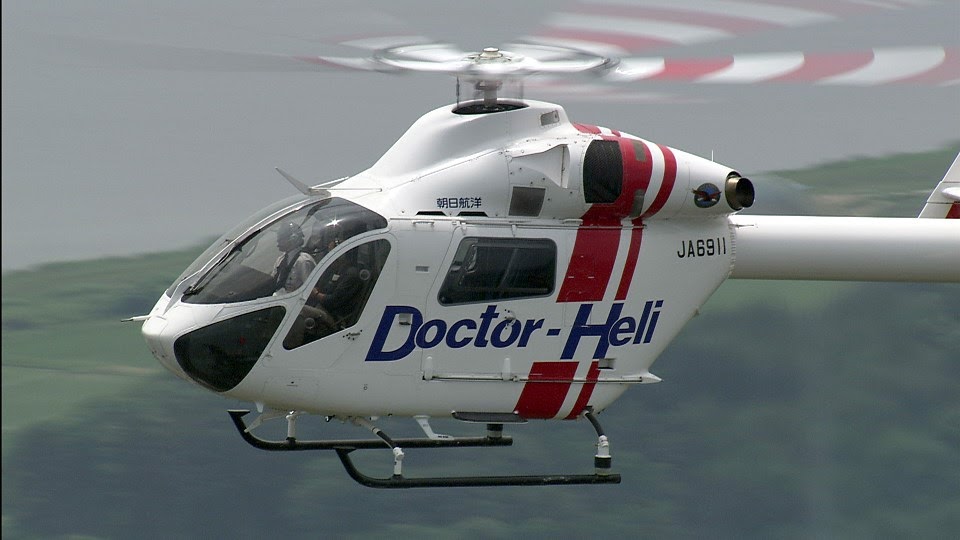
MD900 Helicopter Doctor
The MD900 Helicopter Doctor, engineered by MD Helicopters, is a cutting-edge rotorcraft renowned for its versatility and reliability. This helicopter, first introduced in the late 1990s, was specifically designed to meet the increasing needs of emergency medical services (EMS). It offers enhanced operational safety, improved efficiency, and greater ease of use. These characteristics have made it an ideal choice for air ambulance operations, providing a secure and effective means to transport critically ill or injured patients.
Unique Features of the MD900 Helicopter
A standout feature of the MD900 is its innovative NOTAR® (No Tail Rotor) system. Traditional helicopters use a tail rotor to counterbalance the torque generated by the main rotor, ensuring stability. In contrast, the MD900 utilizes a jet of air to create the necessary anti-torque force, effectively eliminating the need for a tail rotor. This distinctive system enhances safety by reducing the potential for failure and significantly cuts down on noise. This quieter operation proves particularly useful in urban environments or near hospitals, where noise disruption can be a concern.
Key Specifications of the MD900 Helicopter
| Attribute | Details |
| Model | MD900 (MD Explorer) |
| Manufacturer | MD Helicopters |
| First Introduced | 1990s |
| Type | Light twin-engine helicopter |
| Rotor System | NOTAR® (No Tail Rotor) |
| Maximum Speed | 160 mph (257 km/h) |
| Range | 400 miles (644 km) |
| Crew Capacity | 1 pilot + 1-2 medical personnel |
| Passenger Capacity | 1-2 patients |
| Cabin Features | Spacious, adaptable medical equipment storage |
| Engine | 2 x Pratt & Whitney Canada PW206E engines |
| Avionics | Advanced navigation, communication, and weather radar |
| Operational Use | Emergency medical services (EMS), air ambulance, search and rescue |
| Notable Design Feature | NOTAR® system (no tail rotor) |
| Noise Level | Quieter than traditional helicopters |
| Service Operators | Used globally, including Japan, UK, USA, etc. |
| Maintenance Considerations | High operational and maintenance costs |
| Special Capabilities | Suitable for confined spaces, urban areas, and remote regions |
1. Quiet and Safe Operation with the NOTAR® System
The absence of a tail rotor is one of the MD900’s most important design features. Traditional tail rotors are essential for counteracting the torque produced by the main rotor, but they can also be vulnerable to failure, which poses significant risks during emergency situations. By using the NOTAR® system, the MD900 removes this risk, making it a safer option for air ambulance operations.
Additionally, the lack of a tail rotor results in much quieter operation. This is particularly beneficial in areas with noise restrictions or where hospitals and residential zones are located. Less noise means fewer disturbances during takeoff, landing, and flight, which also enhances communication between the medical crew and the pilot, an essential factor during critical missions.
2. A Spacious, Customizable Interior
Another major advantage of the MD900 is its roomy and adaptable cabin. Designed to house various medical equipment and a full medical crew, the cabin offers ample space for the MD900 Helicopter Doctor, paramedics, and nurses to carry out their work. Its large interior also ensures that medical staff have easy access to patients, allowing them to provide treatment and care during flight. This is especially critical in emergency medical services, where every minute matters, and patients often require immediate attention.
Moreover, the cabin’s flexible design means that it can be quickly reconfigured to suit different types of missions. Whether it’s transporting patients in critical condition, conducting search-and-rescue operations, or responding to disaster zones, the MD900 can adapt to meet the demands of various emergency situations.
3. Advanced Navigation and Communication Systems
The MD900 is equipped with state-of-the-art avionics that provide exceptional navigation and communication capabilities. This is particularly important for EMS missions, where reaching the destination as swiftly and safely as possible is crucial. The helicopter’s advanced systems include navigation instruments, weather radar, and communication equipment, ensuring that pilots can navigate even in challenging weather or terrain.
The avionics also enable seamless communication between the helicopter and ground-based emergency teams, allowing for coordinated efforts during patient transport, particularly in areas where access by road is difficult or impossible. This integration of technology ensures a more efficient and responsive EMS operation.
4. High-Speed Performance for Critical Missions
The MD900 is built for high performance, an essential factor for EMS operations. With a maximum speed of 160 mph (257 km/h), it is capable of reaching patients quickly, even in challenging or congested environments. This speed is crucial during time-sensitive operations, such as when treating heart attack victims, stroke patients, or those suffering from severe trauma.
In addition to its speed, the MD900’s range of 400 miles (644 km) allows it to operate over long distances without the need for frequent refueling. This extended range is particularly useful in reaching patients in remote or rural areas, where ground transportation may not be feasible.
The MD900 in Emergency Medical Services
1. Quick Response Times
The MD900’s speed and agility make it ideal for rapid response in emergency situations. In EMS, every second matters, and the MD900’s ability to quickly reach patients is critical in life-or-death scenarios. Its fast takeoff and high-speed capabilities significantly reduce the time it takes to reach those in urgent need of medical care.
Moreover, the MD900’s versatility allows it to operate in a variety of environments, whether urban, rural, or mountainous. This adaptability ensures that air ambulance services can respond to emergencies in virtually any location, enhancing its value as an EMS asset.
2. Delivering Advanced Care During Transport
The MD900’s spacious interior allows medical teams to transport one or two patients while maintaining easy access to necessary medical equipment. This is essential for providing life-saving care during transport. The helicopter is equipped with high-tech equipment like defibrillators, ventilators, and monitoring devices, which enable medical personnel to stabilize and treat patients mid-flight.
This capability greatly improves patient outcomes by allowing critical care to be provided even before reaching the hospital.
3. Flexibility in Diverse EMS Missions
The MD900’s design makes it incredibly flexible in EMS missions. Whether it’s a routine transport, a high-risk rescue operation, or responding to natural disasters, the MD900 is capable of operating in challenging environments such as congested urban areas or mountainous terrains. This versatility has made it a valuable asset for EMS providers worldwide, allowing them to carry out a wide range of missions efficiently.
Global Use of the MD900
Aero-Asahi Corporation in Japan
Aero-Asahi Corporation, operating out of Japan, is one of the leading providers of MD900 air ambulances. The company operates a fleet of MD900 and MD902 helicopters, offering life-saving services across diverse environments, from busy urban centers to rugged mountain landscapes. Their experience with the MD900 has proven the helicopter’s reliability and effectiveness in life-critical situations.
Lincs & Notts Air Ambulance in the UK
In the UK, Lincs & Notts Air Ambulance made the transition to the MD900 in 2000, moving from their previous Bolkow helicopter. The advanced capabilities of the MD900, such as its speed and operational flexibility, have significantly enhanced their service, enabling quicker response times across Lincolnshire and Nottinghamshire. The MD900’s ability to navigate both urban and rural terrains has made it a crucial part of the region’s air ambulance fleet.
Challenges and Considerations for MD900 Operators
Despite its many advantages, the MD900 is not without its challenges. One of the primary concerns for operators is the helicopter’s maintenance costs. As a highly advanced rotorcraft, the MD900 requires specialized parts and skilled technicians for upkeep, which can add up over time. Additionally, the MD900 is an older model, and some operators may consider upgrading to newer models as technology continues to advance. However, its proven performance ensures that the MD900 remains a reliable option for air ambulance services.
Key Facts About MD900 Helicopter Doctor
- Advanced Design with NOTAR® System: The MD900 Helicopter Doctor is renowned for its unique NOTAR® (No Tail Rotor) system, which eliminates the need for a traditional tail rotor. This innovation improves safety by reducing the risk of tail rotor failure and enhances operational stability.
- Enhanced Safety Features: The MD900 Helicopter Doctor is designed to enhance flight safety. Its quiet operation minimizes noise, making it more effective in urban areas or near sensitive locations like hospitals, where noise levels must be kept low.
- Versatile and Spacious Cabin: The helicopter’s cabin is spacious and adaptable, designed to accommodate one or two patients, along with medical personnel and essential medical equipment. This makes it ideal for air ambulance services, ensuring medical teams can operate efficiently while en route to the hospital.
- Advanced Avionics for Precision: Equipped with state-of-the-art avionics, including navigation, communication systems, and weather radar, the MD900 Helicopter Doctor ensures precise navigation and communication, which is crucial in emergency medical missions where timing and accuracy are critical.
- High Speed and Range: The MD900 Helicopter Doctor can reach a maximum speed of 160 mph (257 km/h) and has a range of approximately 400 miles (644 km), making it capable of quickly reaching patients even in remote or difficult-to-access areas.
- Global Adoption for EMS: The MD900 Helicopter Doctor is used worldwide in emergency medical services, particularly by air ambulance operators. Countries like Japan, the UK, and the USA employ this model for its reliability and efficiency in critical medical situations.
- Ability to Operate in Confined Spaces: The MD900 Helicopter Doctor can operate in tight or congested environments, such as urban areas or remote terrains with limited landing zones, making it ideal for rescue and transport missions in challenging locations.
- Cost and Maintenance Considerations: Though highly capable, the MD900 Helicopter Doctor comes with higher maintenance costs due to specialized parts and older technology. However, its performance continues to make it a valuable asset for air ambulance providers.
- Key Role in Life-Saving Operations: The MD900 Helicopter Doctor is an essential asset in EMS operations, as it provides fast and efficient transportation for patients in critical conditions, contributing significantly to saving lives in emergency medical situations.
Conclusion
The MD900 Helicopter Doctor stands out in the field of emergency medical services. Its unique NOTAR® system, advanced avionics, and spacious cabin make it a safe, efficient, and versatile choice for air ambulance missions. With its ability to transport patients quickly, provide advanced care mid-flight, and operate in diverse environments, the MD900 continues to be a critical asset for EMS teams globally. The continued adoption of the MD900 by air ambulance services around the world underscores its exceptional value in saving lives and providing superior medical care.
Frequently Asked Questions
- What is the MD900 helicopter used for?
The MD900 is primarily used for emergency medical services (EMS), including air ambulance missions. It is designed to transport critically ill or injured patients swiftly and safely.
- What makes the MD900 helicopter unique?
The MD900’s key features include its NO TAIL rotor (NOTAR®) system, which enhances safety and reduces noise. It also boasts a spacious cabin, advanced avionics, and exceptional performance in a variety of operational conditions.
- How fast can the MD900 helicopter fly?
The MD900 can achieve speeds up to 160 mph (257 km/h), which allows it to quickly respond to emergency calls and reach patients in need.
- How far can the MD900 helicopter travel?
The MD900 has a range of 400 miles (644 km), enabling it to reach remote or rural areas without requiring frequent refueling.
- What is the capacity of the MD900 for medical missions?
The MD900 can transport one or two patients, along with a full medical team, including the MD900 Helicopter Doctor, nurses, and paramedics. Its spacious interior ensures easy access to both the patients and medical equipment.
- Which countries use the MD900 helicopter for air ambulance services?
The MD900 is used by air ambulance providers across the globe, including in Japan, the UK, and the USA, due to its performance and versatility in varied environments.
- Are there challenges with operating the MD900?
The primary challenges with the MD900 are the maintenance costs and its aging technology, though it remains a reliable and effective tool for EMS operations.
- How does the MD900 improve patient care during transport?
The MD900’s spacious design and ability to carry advanced medical equipment allow medical teams to provide essential care during transport, including monitoring vital signs and performing critical procedures.
Discover the latest news and updates on The Blog Verge





